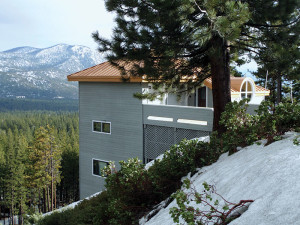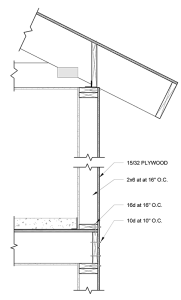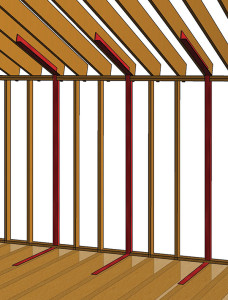Lessons Learned from a Fatal Accident
Recently, an insurance adjuster engaged one of the authors to help determine the replacement cost for vehicle damage to a residential garage. The residence is constructed on a hillside, on the downslope side of the roadway. The house is typical of many at such locations; the garage and public living spaces are at the uppermost/street level and private spaces like bedrooms are located in the story below. Below the lower story is a steeply sloped crawlspace, with walls on the downhill side that are approximately sixteen feet tall. A driveway bridge connects the road to the garage. Figure 1 presents a typical example of this type of residence.
Apparently, upon returning home, the homeowner was parking in the garage and lost control of the vehicle. The vehicle drove through the rear wall and fell down to the ground behind the garage, approximately 30 feet below. The accident was fatal. Surprisingly, the adjuster estimates that he has a claim almost every month in which a vehicle has driven through the rear wall of a residential garage. Although typically, in those incidents, the vehicle drove into the adjoining residence and came to a stop. This was the only fatal incident that he observed.
The adjuster asked the author to prepare a report describing a structural repair to develop a cost for the work. During the course of preparing the report, it became apparent that neither the International Residential Code (IRC) nor the International Building Code (IBC) has specific requirements for vehicle retention in residential garages.
Code Review
A review of the 2012 IBC indicates provisions for vehicle barriers in Section 1607.8.3. “Vehicle barriers for passenger vehicles shall be designed to resist a concentrated load of 6,000 pounds in accordance with Section 4.5.3 of ASCE 7” (American Society of Civil Engineers Standard Minimum Design Loads for Buildings and Other Structures). ASCE 7 specifies additional criteria on how that load is to be applied. What is not immediately obvious is in which situations the designer is required to provide such a vehicle barrier.
IBC Section 406 presents occupancy-related requirements for garages and, within it, Section 406.4 provides guidance for public parking garages that includes requirements for vehicle barriers (Subsection 406.4.3). Specifically, barriers are required at ends of drive lanes or parking spaces where the vertical distance to the ground or surface below is greater than one foot. Note that Section 406 applies to both open and enclosed parking garages, suggesting that enclosing a garage is not adequate and either the wall needs to be the vehicle barrier itself or it needs to be protected by one.
IBC Section 406.3 presents the different and separate requirements for private parking garages and carports. Section 406.3 has no requirement for vehicle barriers. The inclusion of vehicle barrier requirements in Section 406.4 and not in Section 406.3 suggests to the designer that it is appropriate to omit such barriers in private garages.
Since most private garages are in single-family residences, duplexes or townhomes, the building may be designed according to the provisions of the IRC. The authors reviewed the 2012 IRC and found no requirement for vehicle barriers at the rear of garages. As the specific code for residential construction, the IRC provides prescriptive requirements for garage construction. Chapter 6 of the IRC provides prescriptive requirements for walls and includes guidance for a variety of different types of construction.
Wood framed walls are typical for a residence with upper level garages. The authors found that following prescriptive wall construction provisions, a rear wall of a garage might be framed as lightly as 2×4 studs spaced 24 inches on center. Wall sole plates are fastened to floors with 16d nails spaced at 16 inches on center. The exception is for a wall that is a bracing wall panel, in which case it would have three nails every 16 inches.
Analysis
It is apparent that conventional wall framing provides inadequate restraint to vehicle loads. The authors practice in a region that requires that all houses be engineered rather than framed according to conventional provisions. Therefore, the authors analyzed the wall construction that they would typically specify in the region for this type of house. For most residences, the walls would be framed with 2×6 studs spaced 16 inches on center, sheathed to provide lateral resistance, and generally connected according to Figure 2.
When a 6,000-pound vehicle load is applied two feet above the subfloor, for an eight-foot-tall wall, the reaction at the base is 4,500 pounds. An entire wall assembly was evaluated to determine its failure mechanism. ASCE 7 requires applying the vehicle load to an area no larger than 12 inches by 12 inches; therefore, the entire vehicle load is applied to a single stud. The “weak link” is the sole-to-stud nails acting in shear combined with the exterior sheathing nails acting in withdrawal. Considering three sheathing nails acting in withdrawal and two sole-plate-to-stud-end-grain nails acting in shear, the capacity to resist the vehicle load at the base of the wall was calculated to be approximately 2,000 pounds, and that is with a 2.0 load duration factor for impact.
The assembly detailed will not provide adequate restraint for vehicle impacts – the sole-plate-to-stud connection can be expected to fail and a vehicle would not be restrained. During the author’s investigation at the residence where the tragic accident occurred, the observed failure was at the sole plate to stud connection.
Design
Despite there not being a clear code requirement to do so, and because of the significant consequences, many Owners are willing to pay the extra cost for a more robust barrier upon learning the potential risk.
Most Owners are, however, not eager to have bollards about their garages taking up valuable floor space. Considering that, and the difficulty of designing bollards restrained only by the wood floor framing, integrating vehicle restraints into the rear wall of the garage is a solution.
These restraints can be HSS steel posts spaced less than five feet on center – in order to prevent a vehicle from getting between them – within the wall cavity. The HSS posts connect to the roof and floor framing, and transfer the reactions from the vehicle load into the diaphragms and the lateral force resisting system. Figure 3 shows schematically how to incorporate these types of posts into the wall, floor and roof. An additional design feature involves placing a horizontal beam at the vehicle bumper level to better spread the impact load and engage multiple posts.
Conclusion
It appears that current codes for residential garages do not have specific requirements for vehicle barriers, and conventional construction provides little restraint for vehicle loads. For hillside homes with garage floor elevations that are well above the grade beyond the parking area, there is a potentially high consequence if a vehicle is to drive into the rear wall. A recent fatal incident, that one of the authors observed, tragically exemplifies this. Despite this, a wary designer can recognize the risk and design an easily installed and cost effective vehicle barrier in a wood-framed residence.▪



